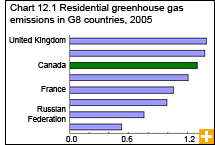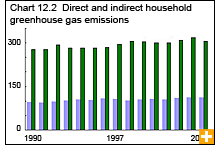Common menu bar links
Environment
Archived Content
Information identified as archived is provided for reference, research or recordkeeping purposes. It is not subject to the Government of Canada Web Standards and has not been altered or updated since it was archived. Please contact us to request a format other than those available.
Each household contributes to greenhouse gas (GHG) emissions in two main ways. Direct emissions from motor-fuel use and residential-fuel use account for one-third of household emissions in Canada. Indirect emissions from industrial production of the goods and services that households consume make up the other two-thirds.
Together, direct and indirect household emissions accounted for 46% of Canada’s total GHG emissions in 2004. The remaining 54% of total emissions came from industrial production of goods and services for other consumers (for example, exports to foreign countries) and from government activities.
Direct emissions
GHG emissions related to households increased 13% from 285,884 kilotonnes in 1990 to 321,727 kilotonnes in 2004. Canada ranked third among G8 countries, just behind the United Kingdom and Germany, in direct household GHG emissions per capita in 2005.
There was an insignificant change in GHG emissions per capita from 1990 to 2004, despite efficiency gains in industry and efficiency improvements in homes. Motor fuels are the largest source of households’ direct GHG emissions.
Household emissions from motor-fuel use increased 29% from 55,770 kilotonnes in 1990 to 71,873 kilotonnes in 2004; this increase outpaced Canada’s population growth of 16% over the same period, reflecting the popularity of larger vehicles that consume more fuel per kilometre. Sales of light-duty trucks, minivans and sport-utility vehicles climbed 74% from 1990 to 2004.
In 2004, 58% of the energy Canadians used in their dwellings came from natural gas and heating oil. Burning these two fuels accounts for 99% of the emissions from fuel use within the home. (Electricity represents 42% of total energy used in the home, but its consumption does not directly result in the release of GHGs.) Emissions from fuel use in the home remained stable from 1990 to 2004.
Households that switched from heating oil to natural gas helped stabilize those emissions. When burned, heating oil releases 47% more carbon dioxide per unit of energy than natural gas.
Indirect emissions
Two-thirds of indirect household GHG emissions, or 137,074 kilotonnes, were linked to goods production in 2004, while the remainder (72,174 kilotonnes) came from producing services. The goods and services that result in the highest indirect GHG emissions are electricity, food and beverages, restaurant meals and accommodations, and motor fuels and lubricants. These categories represented 54% of indirect GHG emissions from households in 2004 and 21% of household spending.
In 2004, the use of electricity resulted in the greatest indirect GHG emissions from households, though it represented a small portion (2%) of total household spending. This is because of the high emissions associated with the production of electricity.




